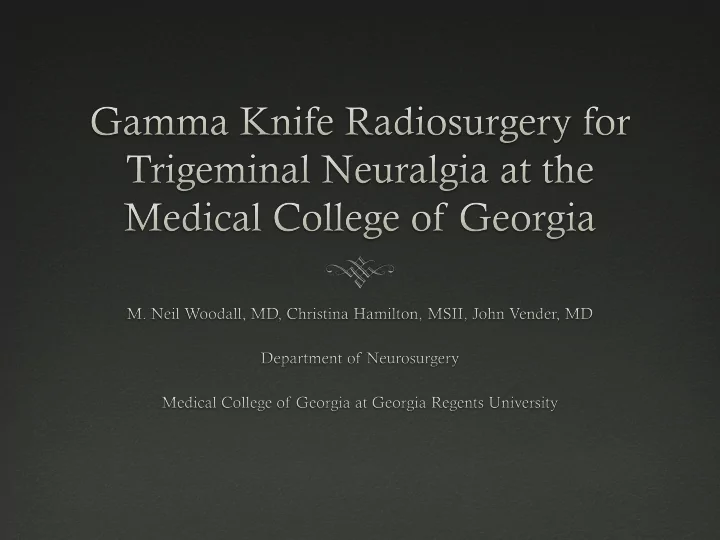

Historical Background John Fothergill – 1773 Charles Bell – 1829 Walter Dandy –1934 Images from Prasad, et al.
Criteria for Diagnosis Paroxsymal, usually unilateral attacks of facial pain in one or more trigeminal divisions lasting <1 sec – 2 min At least one of the following: 1) Intense, sharp, superficial or stabbing quality, 2) Precipitation by “triggers” 3) Relative absence of symptoms between attacks Stereotyped patterns of attacks within individual patients No objective neurologic deficit No other identified causes for facial pain The International Classification of Headache Disorders, 2 nd Ed.
Classification of Facial Pain Burcheil, KJ. “A New Classification for Facial Pain.” Neurosurgery . 2003
Treatment Options Medication Percutaneous Rhizotomy (Glycerol, Balloon, or RFA) Stereotactic Radiosurgery (1951) Microvascular Decompression
Gamma knife for Tic Safe and effective Non-invasive Drawbacks: Durability and trigeminal dysfunction
MCG Patient Demographics 318 Patients treated, Mean follow up 16.25 months (3-120 mo) 33.6% Male/66.4% Female 81.4% Caucasian/15.1% African American No Prior – 76.7% MVD – 4.4% GKRS – 0.6% Other – 18.2%
Pain Characteristics 289 (90.9%) with TN1 or TN2 51.8% Right/47.1% Left/1.1% Bilateral
Treatment Protocol 80.7 Gy mean maximum dose to nerve (70-90Gy) Single Shot (96.8%) 4mm collimator (100%) 82.7% Model B
Response to Gamma Trigeminal Neuralgia Type 1 and Type 2 91.2% with good/excellent outcomes (Class I-III) 60.3% with pain-free outcomes 8.8% with little/no response to treatment (Class IV-V) PFOM 36.3% PFWM 24% PWM 30.9% NR (IV/V) 8.8%
Neuropathy, MS, and Repeat GKRS Good/Excelle nt No Response Pain-Free n Neuralgia 91.2% 8.8% 60.3% 204 Neuropathy 57.1% 42.9% 21.4% 14 MS 77.8% 22.2% 66.7% 9 Repeat GKRS 91.7% 8.3% 37.5% 24
Subgroup Comparison Good/Excellent Pain Freedom p-value p-value Neuralgia vs Neuropathy <0.001 <0.005 Neuralgia vs MS NS NS Neuralgia vs Repeat GKRS NS <0.05 Age <65 vs >65 NS <0.01 Smoking NS NS The neuropathy group was less likely to experience a Good/Excellent outcome, or experience a pain-free outcome than the neuralgia group The Repeat GKRS group was less likely to achieve a pain free outcome, but not less likely to respond to therapy than patients undergoing initial treatment Patients older than 65 were more likely to experience a pain free response than patients less than 65
Retreatment Response Good/Exc No ellent Pain-Free Response n Neuralgia 91.2 60.3 8.8 204 First Tx 94 48 6 50 Second Tx 91.7 37.5 8.3 24 Retreatment mean max dose 69.8 Gy The retreatment group was less likely to achieve a pain free response than the initial treatment group on second treatment (p < 0.05)
Conclusions Gamma knife radiosurgery is an effective option for the treatment of medically refractory trigeminal neuralgia Durability is likely the greatest weakness of this treatment modality Useful for patients with MS as well as Neuropathy, although efficacy may be decreased in these settings Repeat GKRS is possible after initial treatment failure, but a pain free response may be less likely
Thank you Special thanks to Christina Hamilton and Dr. Vender Thank you for your attention
Recommend
More recommend